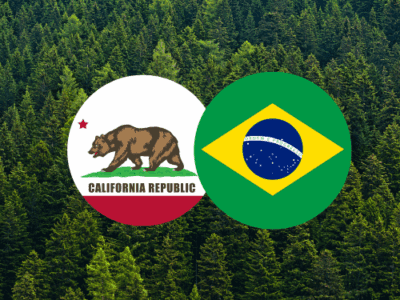The Wilderness Act and climate change
Changing the Wilderness Act to respond to climate change is a terrible idea
The Wilderness Act is one of the iconic pieces of environmental legislation, and it is 50 years old this year. It created a process and management standard by which millions of acres of relatively undeveloped federal land were protected from development and most forms of active human management. These lands are to be managed, as the Act puts it, to ensure that they are “unimpaired for future use and enjoyment as wilderness.” Millions of Americans have enjoyed the solitude and natural beauty available in these areas.
But what is the role of the Wilderness Act in a future dominated by human-caused climate change? A recent op-ed in the New York Times argued that fundamental changes were needed in Wilderness Act management in order to adapt to changes in the climate. According to the author, the “hands-off” philosophy of the Wilderness Act has to give way to allow actions such as watering groves of giant sequoias or cutting trees to reduce fire risks and preserve high altitude alpine meadows. That op-ed is off-base – for two reasons.
First, the op-ed seems to argue that the Act itself needs to be changed to allow for more active, hands-on management in response to climate change:
We need to rethink the Wilderness Act. We need to toss out the “hands-off” philosophy that has guided our stewardship for 50 years. We must replace it with a more nuanced, flexible approach – including a willingness to put our hands on America’s wildest places more, not less, if we’re going to help them.
Though the author does concede that the Wilderness Act “does provide some exceptions to its prohibitions against human interference, including in instances in which an area’s managers consider intervention necessary to protect the wild lands or its creatures,” implicit in the op-ed’s message is a call for fundamental change in how the Act is implemented, a change that likely requires statutory revision. Anything else would inappropriately constrain active management needed to respond to climate change.
If that is what the author is saying, that’s just wrong. I co-authored a recent paper in the journal Environmental Law that examined the scope of management authority available to agencies under the Wilderness Act – and that authority is quite large. Large enough to encompass the vast majority of active management options that land managers might seek to pursue – including watering giant sequoias or even timber harvesting to control disease or fire risk.
The Act does require land management agencies seeking to do these forms of active management to make a range of substantive findings and go through some significant procedural steps in order to establish that active management is really appropriate. And perhaps critics of the Act – including the op-ed’s author – would argue that these steps are too stringent, and make it too hard for active management to occur on wilderness areas.
That leads to the second, and much more fundamental problem, with the op-ed.
Active management is far from a panacea for the threats that climate change might pose to species and ecosystems and landscapes in wilderness areas. Indeed, the fact that active management is difficult on wilderness areas is probably a good thing, because passive management should be the dominant approach to our response to climate change in these areas for a number of reasons.
First, active management probably is most useful in ecosystems that are most impacted by human activities, and therefore require the most assistance to adapt to the additional stresses caused by climate change. These ecosystems are not, in general, located in wilderness areas, but instead in human-dominated and highly managed areas.
Second, we have no guarantee that our active management will actually work to improve the status of species and ecosystems that might be impacted by climate change. History is littered with examples of human intervention in natural systems that went horribly wrong, even with the best of intentions. Sometimes we are far better off doing nothing, simply because we understand so little.
Third, often the best management technique to respond to climate changes is to set lands aside from human management. More protection from stresses from human activities other than climate change is – usually – the most effective way to allow species and ecosystems to adapt to climate change.
Finally, and perhaps most importantly, the strict legal constraints of the Wilderness Act are important to constrain ourselves and our political system – which is all too often susceptible to efforts to obtain short-term benefits by exploiting or developing natural resources at the expense of long-term environmental protection. If the standards of the Wilderness Act became substantially weaker, then opportunities would be created for special interest groups to argue that their “management” project is perfect for “adaptation to climate change” – and is also a “win-win” project because it will also provide jobs, support for the local community, profits for important industries, etc. Changing the law to incorporate management standards that allow the balancing of multiple-goals – like we have for most of the rest of our public lands – will substantially weaken the protections that the law provides against short-sighted management choices – choices that have caused all too much ecological damage on the rest of our non-wilderness, public lands.
The op-ed author notes some of these issues in a “to be sure” paragraph near the end of the piece. But the concession is too little and too weak. And the overall thrust of his argument leads him to proposals that would be disastrous for the wilderness system. For instance, adding more “diverse goals” to the Wilderness Act in terms of management would open the door for political pressure for development projects in these lands, as we’ve seen for decades on the “multiple-use” public lands. Or consider the author’s suggestion that we have “different levels of wilderness, with different levels of human involvement.” Of course, that would open the door for a wide range of development proposals on the “lower” levels of wilderness areas, shrinking the scope of our protected wilderness lands still further. And once we have weakened protections on some lands, there will always be calls that another piece of land should also receive weaker protection because of a particular proposed project that will surely help that ecosystem adapt to climate change.
These are risks that we cannot take. The current Wilderness Act gives us more than enough flexibility to do the limited amount of active management we need to do to respond to climate change.
Reader Comments
2 Replies to “The Wilderness Act and climate change”
Comments are closed.







Thank you for this clear and important rebuttal to what was, frankly, a pretty silly and superficial editorial piece. It was really needed.
Manage our GHG emissions, not the wilderness !!